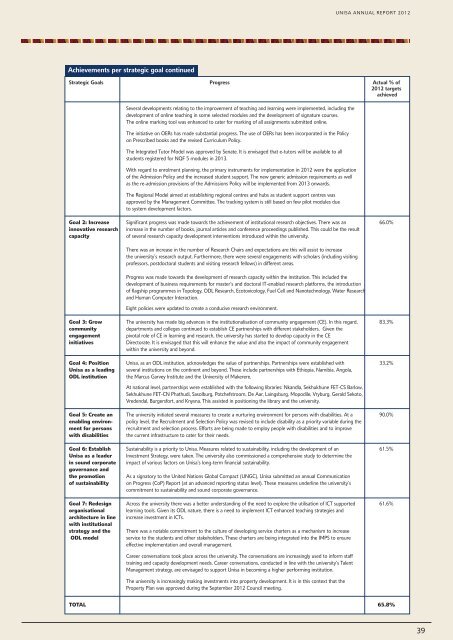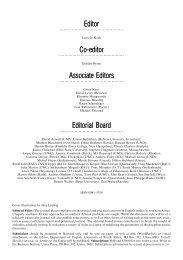ANNUAL REPORT 2012 - University of South Africa
ANNUAL REPORT 2012 - University of South Africa
ANNUAL REPORT 2012 - University of South Africa
Create successful ePaper yourself
Turn your PDF publications into a flip-book with our unique Google optimized e-Paper software.
UNISA <strong>ANNUAL</strong> <strong>REPORT</strong> <strong>2012</strong><br />
Achievements per strategic goal continued<br />
Strategic Goals Progress Actual % <strong>of</strong><br />
<strong>2012</strong> targets<br />
achieved<br />
Several developments relating to the improvement <strong>of</strong> teaching and learning were implemented, including the<br />
development <strong>of</strong> online teaching in some selected modules and the development <strong>of</strong> signature courses.<br />
The online marking tool was enhanced to cater for marking <strong>of</strong> all assignments submitted online.<br />
The initiative on OERs has made substantial progress. The use <strong>of</strong> OERs has been incorporated in the Policy<br />
on Prescribed books and the revised Curriculum Policy.<br />
The Integrated Tutor Model was approved by Senate. It is envisaged that e-tutors will be available to all<br />
students registered for NQF 5 modules in 2013.<br />
With regard to enrolment planning, the primary instruments for implementation in <strong>2012</strong> were the application<br />
<strong>of</strong> the Admission Policy and the increased student support. The new generic admission requirements as well<br />
as the re-admission provisions <strong>of</strong> the Admissions Policy will be implemented from 2013 onwards.<br />
The Regional Model aimed at establishing regional centres and hubs as student support centres was<br />
approved by the Management Committee. The tracking system is still based on few pilot modules due<br />
to system development factors.<br />
Goal 2: Increase Significant progress was made towards the achievement <strong>of</strong> institutional research objectives. There was an 66.0%<br />
innovative research increase in the number <strong>of</strong> books, journal articles and conference proceedings published. This could be the result<br />
capacity<br />
<strong>of</strong> several research capacity development interventions introduced within the university.<br />
There was an increase in the number <strong>of</strong> Research Chairs and expectations are this will assist to increase<br />
the university’s research output. Furthermore, there were several engagements with scholars (including visiting<br />
pr<strong>of</strong>essors, postdoctoral students and visiting research fellows) in different areas.<br />
Progress was made towards the development <strong>of</strong> research capacity within the institution. This included the<br />
development <strong>of</strong> business requirements for master’s and doctoral IT-enabled research platforms, the introduction<br />
<strong>of</strong> flagship programmes in Topology, ODL Research, Ecotoxicology, Fuel Cell and Nanotechnology, Water Research<br />
and Human Computer Interaction.<br />
Eight policies were updated to create a conducive research environment.<br />
Goal 3: Grow The university has made big advances in the institutionalisation <strong>of</strong> community engagement (CE). In this regard, 83.3%<br />
community<br />
departments and colleges continued to establish CE partnerships with different stakeholders. Given the<br />
engagement<br />
pivotal role <strong>of</strong> CE in learning and research, the university has started to develop capacity in the CE<br />
initiatives<br />
Directorate. It is envisaged that this will enhance the value and also the impact <strong>of</strong> community engagement<br />
within the university and beyond.<br />
Goal 4: Position Unisa, as an ODL institution, acknowledges the value <strong>of</strong> partnerships. Partnerships were established with 33.2%<br />
Unisa as a leading several institutions on the continent and beyond. These include partnerships with Ethiopia, Namibia, Angola,<br />
ODL institution the Marcus Garvey Institute and the <strong>University</strong> <strong>of</strong> Makerere.<br />
At national level, partnerships were established with the following libraries: Nkandla, Sekhukhune FET-CS Barlow,<br />
Sekhukhune FET-CN Phathudi, Sasolburg, Potchefstroom, De Aar, Laingsburg, Mopodile, Vryburg, Gerald Sekoto,<br />
Vredendal, Burgersfort, and Knysna. This assisted in positioning the library and the university.<br />
Goal 5: Create an The university initiated several measures to create a nurturing environment for persons with disabilities. At a 90.0%<br />
enabling environ- policy level, the Recruitment and Selection Policy was revised to include disability as a priority variable during the<br />
ment for persons recruitment and selection process. Efforts are being made to employ people with disabilities and to improve<br />
with disabilities the current infrastructure to cater for their needs.<br />
Goal 6: Establish Sustainability is a priority to Unisa. Measures related to sustainability, including the development <strong>of</strong> an 61.5%<br />
Unisa as a leader Investment Strategy, were taken. The university also commissioned a comprehensive study to determine the<br />
in sound corporate impact <strong>of</strong> various factors on Unisa’s long-term financial sustainability.<br />
governance and<br />
the promotion As a signatory to the United Nations Global Compact (UNGC), Unisa submitted an annual Communication<br />
<strong>of</strong> sustainability on Progress (CoP) Report (at an advanced reporting status level). These measures underline the university’s<br />
commitment to sustainability and sound corporate governance.<br />
Goal 7: Redesign Across the university there was a better understanding <strong>of</strong> the need to explore the utilisation <strong>of</strong> ICT supported 61.6%<br />
organisational learning tools. Given its ODL nature, there is a need to implement ICT enhanced teaching strategies and<br />
architecture in line increase investment in ICTs.<br />
with institutional<br />
strategy and the There was a notable commitment to the culture <strong>of</strong> developing service charters as a mechanism to increase<br />
ODL model<br />
service to the students and other stakeholders. These charters are being integrated into the IMPS to ensure<br />
effective implementation and overall management.<br />
Career conversations took place across the university. The conversations are increasingly used to inform staff<br />
training and capacity development needs. Career conversations, conducted in line with the university’s Talent<br />
Management strategy, are envisaged to support Unisa in becoming a higher performing institution.<br />
The university is increasingly making investments into property development. It is in this context that the<br />
Property Plan was approved during the September <strong>2012</strong> Council meeting.<br />
TOTAL 65.8%<br />
39
















